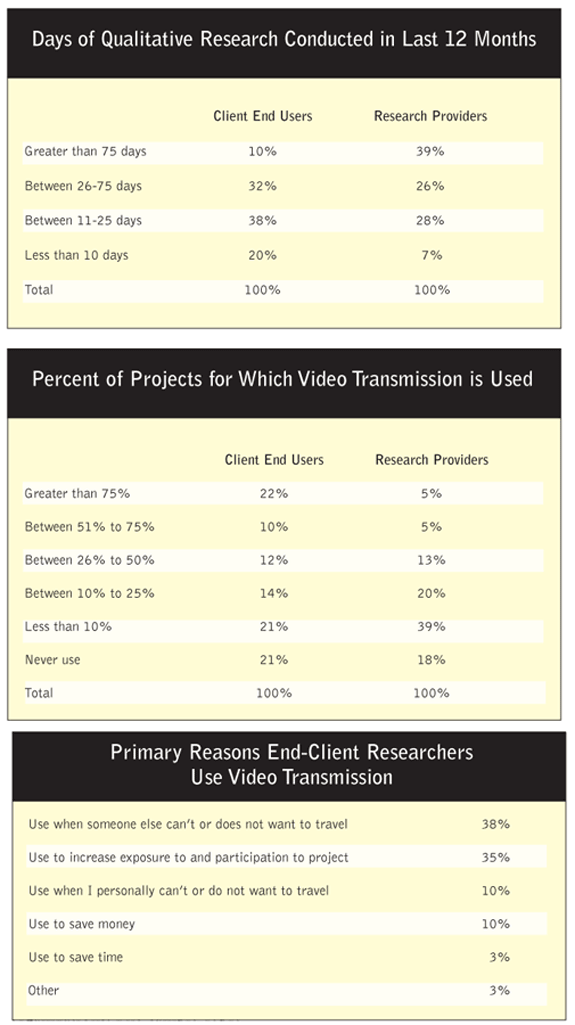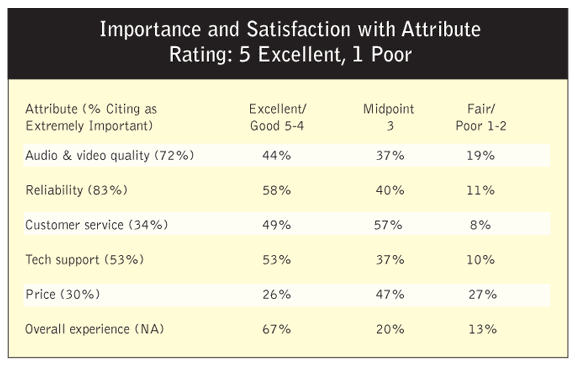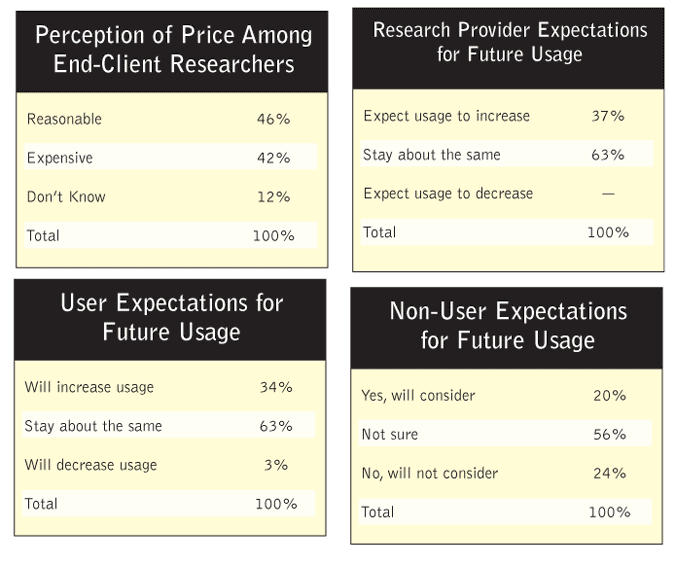Editor’s note: John Houlahan is founder and CEO of FocusVision Worldwide Inc., Stamford, Conn.
Since being introduced in 1990, live video transmission of focus groups has become a frequently used tool in the qualitative research toolbox. Focus facilities worldwide have installed the technology, which allows market researchers to have their projects transmitted live via videoconferencing or video streaming over the Internet to distant viewers. The result for researchers and their colleagues is that now not everyone has to travel to every focus group to participate in this important part of the strategic planning process.
But how is this capability really being used by researchers? Are they getting more people involved in their research or merely replacing their own travel? What is driving usage? What makes a successful transmission in the eyes of users? Why do some not use the technology at all? Will usage increase or decrease in the future?
As a provider of these services, my firm sought answers to these and other questions. We undertook a market survey to determine usage and perceptions of video transmission services for focus groups and other qualitative research within the market research industry. The study was designed, fielded and reported by Stamford , Conn. , research company InsightExpress.
A quota sample of 655 respondents was used, all of whom utilize or conduct qualitative research; 421 were end-client researchers who use video transmission and 117 were non-users of the technology; 152 were providers of research services who moderate and conduct qualitative research.
Note the changes
Before turning to the survey results, it is important to note some of the changes that have influenced qualitative research interviewing since video transmission was introduced 16 years ago. A more conservative business climate with reduced staffing and more cost control has certainly evolved over that time. Events of September 11 further reduced corporate travel. Video transmission technology has improved dramatically and has seen a migration from videoconferencing to video streaming over the Internet.
Focus groups and qualitative research have also increased in status, no longer considered just a “quick and dirty” methodology. Top corporate management is calling for marketing personnel to have intimate knowledge about and personal exposure to customers and prospects. Qualitative research fits these goals. The title of research director is morphing into “director of consumer insights.” Almost every marketing research budget includes qualitative programs. As a result there were an estimated 239,000 focus groups or IDIs conducted in U.S. in 2005 and just over half a million (501,000) when the remainder of the world is added.
So where does video transmission stand today? Here are the survey results:
End-client researchers in the study are primarily department heads and research project managers commissioning qualitative research for end-client organizations. Those in the research provider category include mainly moderators but also project account managers and field coordinators with qualitative supplier organizations. The sample represents a wide range of usage frequency and a significant group of heavy users.
There is also a wide range of frequency of using video transmission for projects, including a number who use the technology for over half of their projects and some who never use it.
Among end-client researchers who use video transmission, the primary usage reasons are to increase exposure to the live sessions so more interested parties can participate overall, or when some team members can’t or do not want to travel. Only 10 percent appear to be using video transmission primarily to replace their own travel. This indicates that research personnel often feel they must, or prefer to, attend groups in person, but offer the option of video transmission to team members for convenience and to optimize the value of the qualitative project. These account for 73 percent of primary reasons for usage. Other reasons such as to save money or save time are 10 percent or below.
Non-users seem reasonably open-minded about possible future use. They do not appear to have negative perceptions or serious concerns about the technology; it seems to be more a lack of information.
Perceived high price is a stumbling block for some, but most just don’t know about price. Verbatims reveal that there is some apprehension that distant viewers may get distracted or not be fully attentive. Some researchers feel “it is just not the same as being there.” And because all viewers are not together under the watchful eye of the research leader, some may jump to premature, unwarranted conclusions.
What users want
The most important attributes that users insist on are very straightforward: audio and video quality, and reliability. And users seem satisfied with the performance of video transmission on these attributes. As a summary measure, 67 percent rated the overall experience excellent/good, 20 percent neutral, and 13 percent fair/poor.
In direct questioning about perceptions of price, there is a dichotomy. While 46 percent consider the price for video transmission reasonable, 42 percent think it is expensive.
Future usage
The future looks good for video transmission. When asked about future use expectations present users and non-users of video transmission responded, as shown in the tables.
Moderators, of course, need to be at the focus facility in order to conduct the sessions. However, the study showed that research provider experience has been generally satisfactory when clients use video transmission, so if the client wants it, it is OK with them. And many expect their involvement with video transmission will increase in the future.
Recognition and acceptance
As the survey results show, video transmission has clearly found a place in many corporate research programs. There is recognition and acceptance that this technology can enhance qualitative research by making the live events more accessible for research and marketing personnel who use the information.



